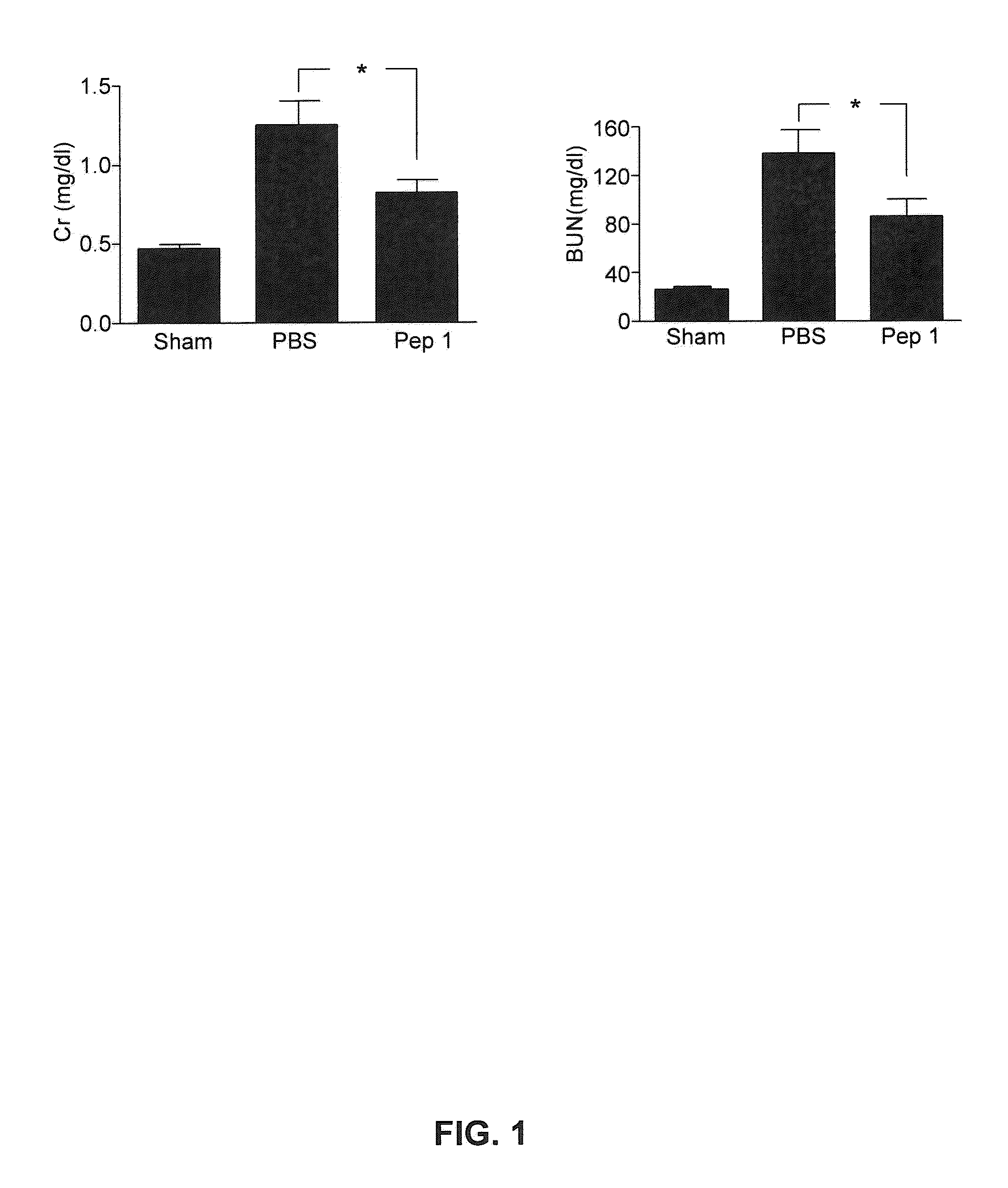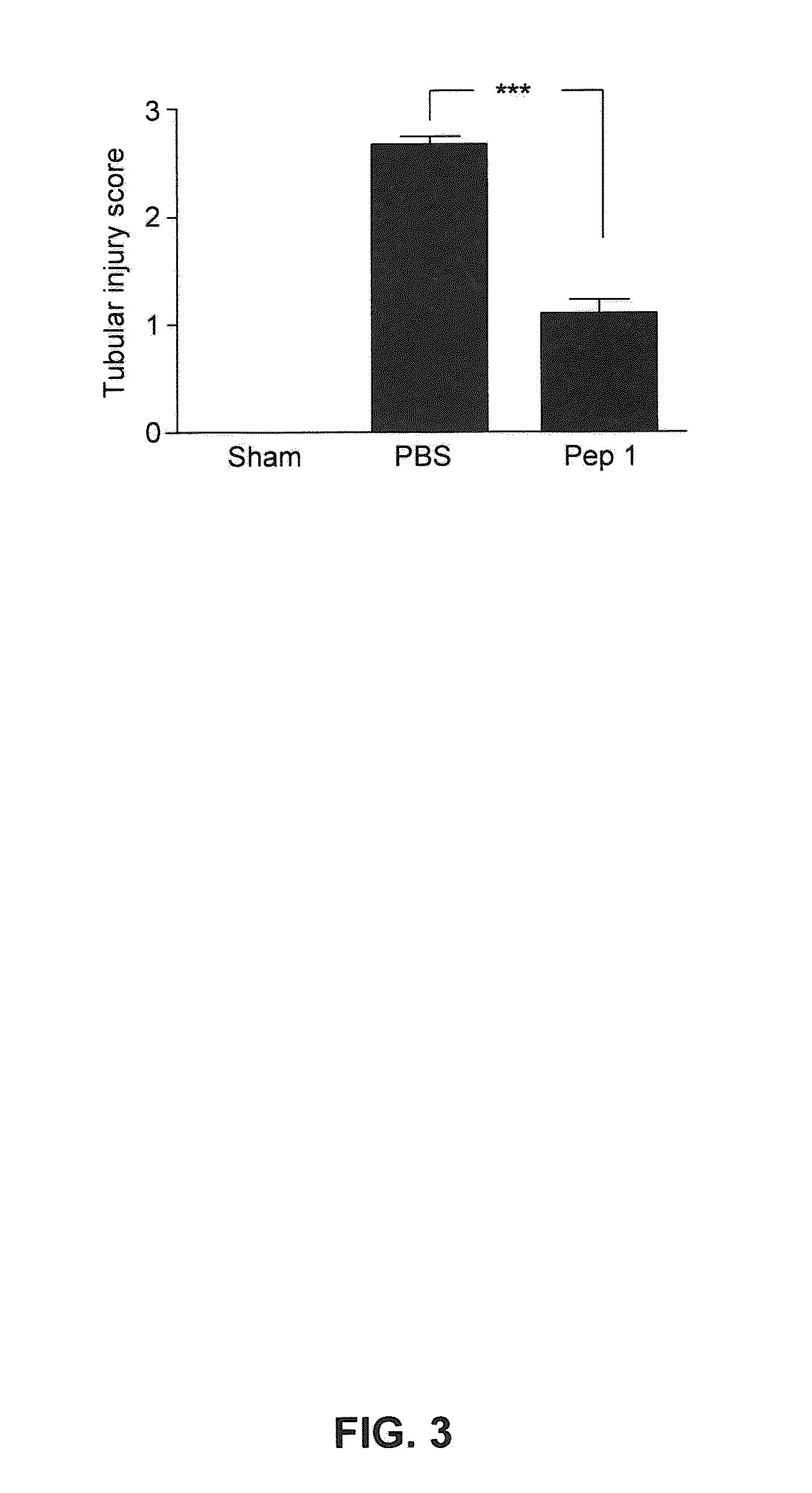Composition for treating and preventing ischemic damage
a technology for ischemic damage and composition, applied in the direction of peptide/protein ingredients, extracellular fluid disorder, transferases, etc., can solve the problems of increased mortality rate, increased risk of acute rejection in organ transplantation, and organ dysfunction, and achieve the effect of superior effect of treating and preventing an ischemic injury
- Summary
- Abstract
- Description
- Claims
- Application Information
AI Technical Summary
Benefits of technology
Problems solved by technology
Method used
Image
Examples
example 1
Synthesis of Peptide
[0077]The peptide of SEQ ID NO: 1 was synthesized according to the conventionally known method of solid phase peptide synthesis. More specifically, the peptide was synthesized by coupling each amino acid from C-terminus through Fmoc solid phase peptide synthesis, SPPS, using ASP48S (Peptron, Inc., Daejeon ROK). Those peptides with their first amino acid at the C-terminus being attached to a resin were used as follows:[0078]NH2-Lys(Boc)-2-chloro-Trityl Resin[0079]NH2-Ala-2-chloro-Trityl Resin[0080]NH2-Arg(Pbf)-2-chloro-Trityl Resin
[0081]All the amino acids to synthesize the peptide were protected by Fmoc at the N-terminus, and the amino acid residues were protected by Trt, Boc, t-Bu (t-butylester), Pbf (2,2,4,6,7-pentamethyl dihydro-benzofuran-5-sulfonyl) that can be dissolved in an acid. Examples include the followings:[0082]Fmoc-Ala-OH, Fmoc-Arg(Pbf)-OH, Fmoc-Glu(OtBu)-OH, Fmoc-Pro-OH, Fmoc-Leu-OH, Fmoc-Ile-OH, Fmoc-Phe-OH, Fmoc-Ser(tBu)-OH, Fmoc-Thr(tBu)-OH, Fm...
example 2
Confirmation of PEP1's Effect of Inhibiting Renal Injury in Renal Ischemic-Reperfusion Injury Model
TEST EXAMPLE 1
Induction of Ischemic Reperfusion
[0095]A renal ischemic-reperfusion injury mouse model was established by inducing ischemic reperfusion by bilaterally clamping renal pedicles for 30 minutes and restoring blood flow 30 minutes later by removing the clamps. Test groups were divided into an administered group (PEP 1), a control group (PBS without PEP 1), and a sham group (no bilateral clamping). PEP 1 was subcutaneously injected at a concentration of 1000 nmol / kg 30 minutes before and 12 hours after the induction of ischemic reperfusion.
[0096]C57BL / 6 mouse (8 weeks old; Charles River Laboratories, Wilmington, Mass.) was used to induce renal ischemic-reperfusion injury. After blocking blood flow by clamping the renal pedicles with vascular forceps and inducing ischemia for 28 minutes, reperfusion was performed.
[0097]The peptide PEP 1 was diluted in PBS to a concentration of ...
example 3
PEP 1's Effect of Improving Rectus Abdominis Myocutaneous Flap Survivability in Ischemic-Reperfusion Injury Model
PUM
| Property | Measurement | Unit |
|---|---|---|
| periodic acid-Schiff | aaaaa | aaaaa |
| length | aaaaa | aaaaa |
| elongation | aaaaa | aaaaa |
Abstract
Description
Claims
Application Information
 Login to View More
Login to View More - R&D
- Intellectual Property
- Life Sciences
- Materials
- Tech Scout
- Unparalleled Data Quality
- Higher Quality Content
- 60% Fewer Hallucinations
Browse by: Latest US Patents, China's latest patents, Technical Efficacy Thesaurus, Application Domain, Technology Topic, Popular Technical Reports.
© 2025 PatSnap. All rights reserved.Legal|Privacy policy|Modern Slavery Act Transparency Statement|Sitemap|About US| Contact US: help@patsnap.com



